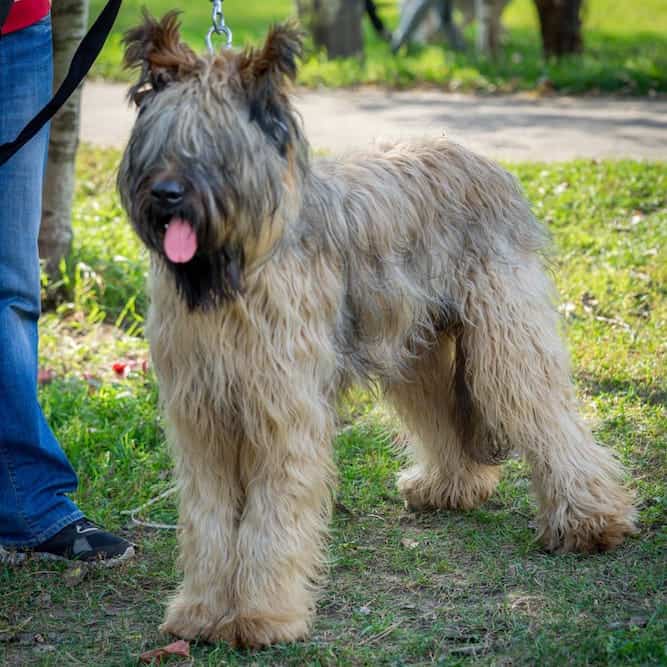Bred as a herder and guard dog in France, the Briard temperament is loyal, fearless, and protective.
Briards, or Berger de Bries in French, were bred to protect flocks from poachers and wolves, gaining a reputation as a brave and heroic breed. We also know from their history that they were used to hunt and track game.
Most likely a descendant from Sheepdogs, today’s Briards enjoy their life as a companion dog.
Briard Temperament and Personality
They Make Excellent Family Dogs
Briard dogs are known as a “heart wrapped in fur.” They are a devoted breed who love to be around their humans. Their perfect day is following you around the house followed by a nap on the couch.

They are Great with Children
The Briard dog is a playful and loving companion. They are protective of children and have even been known to “defend” them when they are being disciplined from the parents!
While they may sometimes try to “herd” children (more on that in a bit), Briards are, for the most part, exceptionally well-behaved around children.
They also Get Along with Other Dogs
Briards tend to be territorial with other dogs. However, if you raise your Briard with other dogs or pets, they will get along well. But Briards do have a strong prey drive, so training is required to prevent their chasing small animals.
This really only extends to cats, though. If you have super-small animals, like lizards, hamsters, or birds, you should definitely consider another breed that isn’t as prey centric.
Briards can be Aloof with Strangers
The Briard breed makes for a fantastic guard dog, as he can be reserved and aloof with strangers but loving and loyal towards his family and friends. The Briard will keep an eye on a person he doesn’t know, watching to see how they interact with his masters. If everything seems copasetic, then he’ll settle in and feel more comfortable with that person.
However, some Briards can take their watchfulness to a whole new level, becoming shy or creepy at best and aggressive at worst. The more you socialize your Briard while he’s still young, the less likely his watchfulness will manifest into anything more than keeping an eye on the situation.
In fact, he may actually become a social butterfly with socialization – something he might never have achieved without it.
Teach Him to Keep His Head
The Briard may forget at times that he is a dog, not a bull. If he wants to herd, say, a small child, he may try to use his head to push them around. However, he does not (or does he?) realize his own strength, so he could end up causing someone to fall and/or suffer an injury with that powerful melon of this.
Other ways he may try to “herd” his “flock” include barking at them, poking them, or nudging this. While this is all cute when he’s still young, it’s not so cute when he grows into a larger, more cumbersome body.
Make sure you train him out of this habit while he’s still young – and while his head is still much smaller!
They are Adaptable
A Briard can be a city or a country dog. They are fairly calm when indoors but do require daily exercise.
One thing they’re not, though, is a kennel dog. If you’re going on vacation, prepare to bring the Baird with you. He does not do well when separated from his family for long periods of time.
They are Athletic
You’ll be amazed to watch the Baird in action. They may not look it, but these dogs are quite athletic! The Baird is one of those dogs who looks like a cumbersome big guy, but then shocks everyone with his agile moves!
A Brief History of the Briard Breed
So, I already mentioned that the Briard came from France. His breed dates all the way back to the 8th century -perhaps even earlier.
Here’s an interesting tidbit: world leaders had a serious affinity for this dog, from Napoleon and Charlemagne to Lafayette.
When the latter sent the Briard to the U.S. to protect Thomas Jefferson’s livestock, Jefferson quickly turned from someone who hated dogs into someone who loved the Baird!
How Do you Train a Briard?
The Briard dog breed temperament allows them to make decisions without human help. While this is great when performing a job, it can make training difficult.
This is because the Briard is an independent dog. As such, he may think that he can push you around whenever he doesn’t want to do what you want him to do. You must be able to assert your dominance so that he understands that you’re the one running the show around here – not him.
Briards are eager to please, though, so they do respond well to training. But, only use positive reinforcement training. The Briard is a sensitive breed, so any negative training will cause a Briard to be stubborn and resist you – kind of the opposite of what you want from the training experience!
Not only that, but this elephant doesn’t forget. Even if you’re only harsh with him on one occasion, he will remember that and make every training session from then on an unpleasant one. So, mind your Ps and Qs with this dog!

With praise, treats, and play – along with short and fun sessions – the Briard will learn quickly.
Briards do exceptional in dog sports or roles thanks to their great memory and intelligence. They’ll excel at agility, obedience, search and rescue, and more.
And again, and because I can’t say it enough: early socialization will help Briards with their weariness of strangers and help them grow into well-rounded adults.
For help with training your Braid, The Online Dog Trainer is a great resource with hundreds of videos that you can check out.
Finding the Perfect Briard

Ready to add a Briard to your family?
Great!
Now it’s time to decide whether you’d like a Briard puppy or an adult.
Briard puppies are cute – but they are a lot of work!
Are you ready to take on the responsibilities of a puppy? They need consistent training, socialization – and a lot of patience!
If you aren’t quite ready for a puppy, why not adopt an adult Briard?
Briard adoption is a great way to not only help a shelter dog but to add an adult dog to your family.
Adults are often already trained and don’t require the amount of time a patience a puppy would.
A great place to start your search is the Briard Club of America. They have information on both Briards for sale from breeders as well as Briard rescue.

Briard Puppies for Sale
Briard puppies for sale from a breeder will cost between $1000-$1200.
A Briard's dog price depends on where you live, whether they are of a champion bloodline, and litter availability.
If you are looking to purchase a Briard with a champion bloodline, expect to pay closer to $1200.
Adopting a Briard from a rescue will cost between $200-$500 and depends on where you live and the rescue organization.
Briard Rescue and Adoption
Briard rescue is perfect for families who want an adult dog or even ones with special needs. A special needs dog can have anything from a treatable skin condition to a serious illness.
A Briad Adoption is also an option for those looking for a Briard mix. While shelters won’t always have purebred Briards, you may be able to find a mix at your local rescue or shelter.
Briard Breeders
If you would prefer to purchase a Briard from a breeder, your first stop should be the AKC Marketplace. They have Briard breeders based on location along with litter availability, bloodline, and gender.
Take your time finding a reputable Briard breeder. Plan visits to different breeders and carry along a list of questions to make sure they are reputable. A reputable breeder will also ask you questions in return to determine if the Briard is the right breed for your family.
Take note on how the breeder treats their dogs and puppies along with the cleanliness of their kennels. Reputable breeders will also provide the necessary health certificates.
Top Briard Mixes
If you’re interested in a Briard mix, there aren’t too many popular ones out there.
Right now, you could look for either an Afaird (an Afghan Hound mix) or a Bridoodle (Poodle mix), but that’s about all I can recommend at the moment.
Caring for a Briard
The Briard is a larger breed, standing between 23-27 inches in height for males and 22-25.5 inches for females.
Their weight is between 55-100 pounds and they live up to 12 years old.

Grooming a Briard
Briards are a low to non-shedding breed. They have an outer coat and an undercoat. The outer coat is coarse and slightly wavy whereas the undercoat is soft and fine. They come in a variety of colors such as black and shades of tawny and grey.
Although Briard shedding is minimal, they do require considerable grooming. They need daily brushing as well as bathes every six to eight weeks. Briards can become dirty easily, so regular trips to the groomer are recommended.
Further, the Briard’s coat is notorious for mats and tangles. So, if you don’t have the patience the Briard’s coat requires, then the Briard is not the right breed for you.
If you’re wondering if the Briard is hypoallergenic, I have bad news for you. Because they are larger dogs who have larger bodies, they produce more dander than their smaller dog counterparts. They are therefore worse to have around for those who suffer from allergies than a smaller dog might be.
Cropping the Briard Ears
You may have seen instances where a Briard’s ears are cropped, and you may be wondering why. The answer is that, in several countries, the U.S. included, breeders crop the Briard’s ears so that they will stand up tall.
One of the main reasons cited for starting the practice of cropping a Briard's ear was to make the breed a more alert and effective herder.
It makes sense that log droppy ears as is natural for the Briard may put it at a disadvantage against predators.
As well, cropped ears are likely easier to maintain and keep clean.
Most cropped breeds have pointed ears. However, the Briard’s crop is more of a rounded shape.
In some areas, such as Australia, the U.K., and countries throughout Scandinavia, this practice is actually illegal.
Staying Healthy
Briards are prone to several health conditions such as:
- Hip Dysplasia
- Elbow Dysplasia
- Congenital Stationary Night Blindness (CSNB) – affects eyesight
- Hyperthyroidism – a thyroid gland disorder
- Progressive Retinal Atrophy – an eye disease that affects the retina
- Von Willebrand’s disease – a blood disorder that affects clotting process
Note: Don't let the many issues above scare you. The best way to approach health problems is to prevent them in the first place. The Ultimate Guide to Dog Health is a great place to start. Get a copy to keep at home. It will help you prevent the painful health issues that can plague your lovely Briard pet from expressing his winning personality and maximizing his life expectancy.
Exercise
Briards need moderate exercise. They love to have a job – especially one that provides exercise. Their energetic nature makes them perfect companions for cyclers, hikers, or joggers.
A securely fenced yard is perfect for the Briard – they love to run around and play fetch with their humans in the backyard.
Plus, a fence keeps the Briard from chasing small “prey” out into the road, or miles into the woods and far away from home.
Aim for 30-60 minutes of daily exercise to keep your Briard happy and healthy.
This includes mental exercise as well as physical. Give a Briard a challenge, and he’s in his glory. Don’t, and he may look for other ways to express his creative side, like with destructive chewing or digging.
Conclusion: Why the Briard?
The Briard is a faithful, protective, and fearless breed. They are a tried and true family dog who absolutely adore children.
Briards are intelligent but can stubborn when it comes to training. Use positive reinforcement and keep training sessions short and fun.
If you are an active family that is looking for an intelligent, loyal, and devoted breed, the Briard is for you.

Kailyn has worked as a professional freelance writer since 2012, and during that time she has written about nearly every dog breed imaginable. Her mother loved Collies, and so Kailyn grew up with three of them throughout her childhood – including a blonde one who was half-blind! Now her home belongs to her first official dog, Macho, a Dogo Argentino rescue.